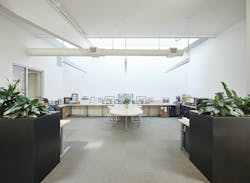Environmental ‘Surfing’ Not so Tough
While energy savings, and resiliency measures, absolutely, factor into justifying the cost of deep conservation measures, it might be the addition of the accounting of human benefits, as part of a comprehensive ROI formula, that will help designers win the day for passive house or net-zero initiatives for clients and owners hesitant to make the jump. So says Carnegie Mellon Professor Vivian Loftness, a participant in international skylight manufacturer Velux’ most recent Daylight Symposium in Paris, in the Fall of 2019. Here are some numbers, Loftness said, design teams should plug in right off the bat:
• External shading can displace 20%-40% of today’s cooling loads;
• Natural ventilation can displace 50%-70% of today’s ventilation loads;
• Daylight harvesting can displace 75% of today’s lighting loads.
“Every window has to meet the need for natural light, natural ventilation and views,” said Loftness. The next step however, is to factor carbon reduction from such measures; doing so, she said, saves about $0.02/kWh, and drops ROI to about 6.5 years, from pure energy’s more typical eight-year payback.
Of course, passive thinking takes a different design mindset. For example, she pointed out a passively designed convention center in Cape Town, Africa, where only lecture/break-out rooms were conditioned. Aggressive night cooling also needs to be part of this equation. She warned designers, however, to be careful of technology as a means to cut corners. “LED has been extremely helpful—it has cut lighting loads by half to two thirds. But in some ways, it is making people sloppy again,” said the professor. “Adding in daylight response controls, and designing around daylight—that is where we can really get going and make a difference—and we are not even tapping into renewables, yet.” Of course, Loftness said all decisions must be made based on their occupant outcomes. The good news is this is something Carnegie Mellon has been studying. Views, for example, they've found, really matter. “So your view plane and kick plates become really critical. And if you are incorporating natural ventilation strategies, the entire façade plays a role.” As for the third factor—human benefits—they may be the most important of the "accounting" metrics. For example, at a call center for the Sacramento Municipal Utility District, call times, for workers with views, improved 6% to 7%. According to the 2004 Preziosi study, buildings featuring natural ventilation saw a 57% reduction in employee sickness absenteeism; hospitals studied saw a drop in patient stay time by nearly 35%. In an RPI study of students at a North Carolina grade school, children with aggressive daylight measures fell asleep in half the time on average.
“When you add all these benefits together, payback is in a year, so the triple-bottom-line of mixed mode daylight and ventilation, justifies such design in places we live, learn and play.”
